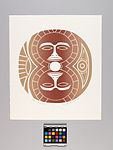Twins
About this object
Narrative
In an interview with Art Curator Karen Duffek (1985), Susan Point identified this as a traditional design off of a spindle whorl. "It's a duplicate of a slide [provided by Mike Kew]. If you look at the traditional pieces they're never symmetrical - there's always a difference. In my earlier pieces, though, I more or less made them symmetrical; normally there was one little difference. I don't know why."
Cultural context
contemporary art; traditional motifs
Iconographic meaning
Anthropologist Homer Barnett notes that: "Twins were connected with salmon in the ideology of the northern [Coast Salish] groups only. Among them twins were always good fishermen... Twins knew when the salmon were coming and could make them hasten. They also knew what kind of salmon each newborn twin was. It was said that twins were salmon and that, when they died, they returned to the salmon home up north (1955:136)."
Physical description
Silkscreened print of a spindle whorl design with two human faces, arranged to create a mirror image effect, with their chins resting on a centre hole. The ink used in the centre of the design, for the human figures, is reddish brown in colour. The ink on the edges is a yellowish brown. There is a tail on the left side of the faces, and a triangular element with an eye-like feature on the right. Handwritten in pencil along the bottom: 24/30 Spindle Whorl "Twins" August 1985 Susan A. Point.
